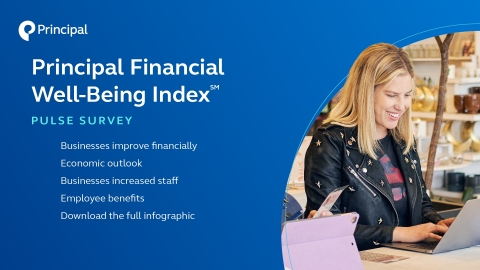Small Businesses Make Financial Gains, Closing the Gap with Large Businesses
The Principal Financial Well-Being Index indicates SMBs are increasingly hiring, with 42% reporting staff increases compared to 19% in November 2020. Financial health is improving, with 67% of businesses noting advancements, up from 44% last year. However, uncertainties remain, as only 46% of smaller businesses feel confident about their financial outlook for the next 12 months. Rising employee turnover is a challenge, with 67% of smaller business employees voluntarily leaving. Additionally, childcare support is now prioritized as a key benefit to attract talent.
- 42% of smaller businesses report increased staff compared to 19% in November 2020.
- 67% of businesses report financial improvement, up from 44% last year.
- The gap in financial health between smaller and larger businesses is narrowing.
- Only 46% of smaller businesses are confident about the next 12 months.
- Employee turnover is increasing, with 67% of smaller business employees voluntarily leaving.
Principal Financial Well-Being Index SM finds small businesses are hiring more as current optimism grows
-
Despite a competitive labor market,
42% of smaller businesses report increased staff vs19% inNovember 2020 . - Gap in financial health between smaller and larger businesses is narrowing, with smaller businesses seeing greater financial improvement.
-
67% of businesses report financial improvement vs44% at this time last year. - For the first time, employers are planning on increasing childcare support as a key employee benefit to attract new employees.

Third wave of business insights for 2021 (Photo: Business Wire)
“The last 18-plus months have tested small businesses and caused many to fundamentally change their businesses, find new ways to operate, take care of their employees, and get work done. They’ve navigated through this crisis and are gaining confidence. Small businesses are using the new muscles they built to accelerate financial growth and increase staff in support of that growth,” says
The latest Principal Financial Well-Being IndexSM (WBI), in its eighth year, reveals the gap between smaller and larger businesses is narrowing when it comes to growth and financial improvement. Smaller businesses2 report greater financial improvement (
These findings are from the latest WBI pulse survey of 500 employers from companies with two to 10,000 employees and span a diverse array of industries, with more than half of the employers falling within finance/insurance, professional/scientific/technical, construction, manufacturing, and information management industries.
Businesses are cautious about economic outlook
While SMBs feel confident about their current economic security now, their 12-month outlook is less optimistic. Smaller businesses, in particular, are concerned about the year to come. Only
While most businesses included in the survey reported being fully operational (
"Although businesses are feeling confident today, they continue to work through a more complex economy. Employers are concerned about tougher competition for talent, supply chain shortages and the ongoing impact of COVID-19,” says Friedrich. “The pandemic created a lot of uncertainty especially for smaller businesses, which is lingering on and could again affect future growth. While businesses have gotten better at adjusting to volatility, they know personally how a new wave of economic instability can quickly impact revenue.”
Small businesses have made significant gains in staffing since last year
Businesses continue to show great resilience through the economic recovery. Despite the national competition for labor, smaller businesses’ hiring efforts have surged over the last 12 months. Forty-two percent of smaller businesses are increasing staff, compared with only
However, while smaller businesses have gained ground in hiring, they are also experiencing an increase in turnover. The survey shows a rise in resignations for smaller companies as employees seek retirement or new opportunities that fit their needs. Sixty-seven percent of employees are voluntarily leaving smaller businesses compared to
“We’re seeing evidence of the labor dislocation, especially among smaller businesses. I suspect we’ll continue to see increases in hiring as more become fully operational,” observed Friedrich. “Employees are paying attention to the shift happening and believe they have more options than before. Retention will be more critical now as employers compete for employees.”
Aside from retirement, employees are citing additional childcare and caregiving responsibilities as a major obstacle and a top reason why they’re leaving their current jobs. Additionally, employees are taking advantage of the current environment by changing career paths and relocating to different geographic regions.
Employee benefits focus on changing workforce
Employee benefits continue to play a critical role in recruitment and retention as the national competition for labor ramps up. Training and education benefits jumped to the top of the list for employers who say they want benefits to help retain current employees or to improve the employee experience. Additionally, SMBs identified healthcare as a top benefit to attract new employees; it was also the second most popular for employee retention.
As businesses contend with the staffing shortages and transitions, employee benefits can help employers stand out in the fight for talent by meeting employees’ unique needs. Childcare support was identified as an additional key benefit for employee attraction – the first time it has made an appearance as a tool for employee attraction. Nearly two years into the pandemic, childcare remains an obstacle for many families. Providing support can help individuals reenter or remain in the workforce.
“Employees are seeking jobs that fit their personal needs outside of the office. These needs include opportunities for professional certification and degree programs, support for caregiving responsibilities and mental health support,” says Friedrich. “Matching employee needs with employee benefits is critical in the competition for talent and could help retain current employees.”
Other popular employee benefits included telehealth, whose popularity rose rapidly during COVID-19, mental health and well-being programs, financial wellness programs, employee assistance programs (EAP) and paid family or medical leave.
See all results and insights from the latest Principal Financial Well-Being IndexSM (PDF).
______________________________
1 Business with 2 to 10,000 employees.
2 For the purpose of the study, we define smaller businesses as those with two to 499 employees.
3 Business with 500 to 10,000 employees
About the Principal Financial Well-Being IndexSM
The Principal Financial Well-Being IndexSM surveys business owners, decision makers and business leaders aged 21 and over who work at companies with 2 – 10,000 employees. The nation-wide survey, commissioned since 2012, examines the financial well-being of American workers and business employers. In response to COVID-19, the Well-Being Index was transformed from an annual survey to a quarterly pulse, offering three waves, revisiting questions and measuring sentiment regarding timely issues in the small and medium-sized business marketplace. The survey was commissioned by Principal and conducted online by Dynata from
Principal developed a dedicated portal for employers designed to help business handle the effects of COVID-19 and a challenging economy in the months ahead. To learn more visit Navigating Business Now.
About
[1] As of
[2] As of
[3]
[4] Pensions & Investments, 2020.
Dynata is not an affiliate of any company of the Principal Financial Group®
Insurance products issued by Principal National Life Insurance Co (except in NY) and
© 2021
1932670-112021
View source version on businesswire.com: https://www.businesswire.com/news/home/20211207005422/en/
miller.ashley@principal.com
515-878-6295
Source:
FAQ
What does the Principal Financial Well-Being Index reveal about small businesses in 2023?
How does the financial health of small businesses compare to larger businesses according to the Index?
What percentage of small businesses anticipate a positive financial outlook for the next year?
How are employee retention efforts changing in small businesses according to the recent report?







